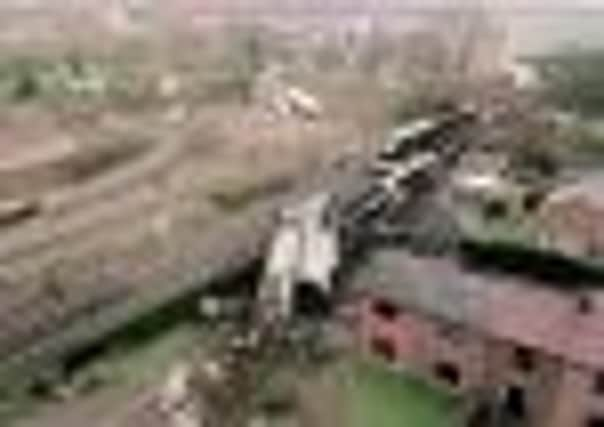‘The biggest tragedy of all is that it was preventable’


“They were walking, but some of them had severe injuries and there was a lot of blood around. They were crying for help.”
A decade has passed, but this vivid recollection of wounded passengers clambering to safety from the wreckage of a train at Great Heck will never leave paramedic Steve Goulden, one of the first rescuers on the scene.
Advertisement
Hide AdAdvertisement
Hide AdMr Goulden and colleague Bob Chambers had been on duty for 11 hours when they were called to a report of a derailed train a few miles south of Selby shortly after six o’clock in the dark, snowy morning of February 28, 2001.
They were confronted with a situation far worse than they had imagined. Two trains had collided head-on, one a Freightliner carrying more than 1,700 tonnes of coal from Immingham to Ferrybridge power station, the other a GNER inter-city service taking about 100 people to London Kings Cross.
As the sun rose, and the trail of upturned carriages, broken glass and mangled metal came into view, so began a rescue mission that none of the emergency workers present will ever forget.
Within minutes, Mr Goulden’s modest supplies of dressings, first aid kits and oxygen had all been used and help from across the region was on the way.
Advertisement
Hide AdAdvertisement
Hide Ad“I remember seeing blue lights on the nearby railway bridge and hurtling across the field and up the embankment to meet them,” Mr Goulden said.
“It was a horrendous situation. We were trained to assess a road accident where you maybe have three, four or five casualties, but certainly not 80 to 90 people.
“We were thinking, ‘Good God, where do we start?’”
Northern Straw, a company overlooking the crash site, opened its barns to shelter the injured as rescuers went to search for casualties trapped in the wreckage.
The conditions could hardly have been more hazardous. Pools of blood and waste from damaged toilets coated the floors of the jagged-edged carriages, which lay near 25,000-volt electricity pylons and gallons of spilt diesel.
Advertisement
Hide AdAdvertisement
Hide AdMal Austwick, who was the sub-officer in charge of Tadcaster fire station’s Red Watch crew, said the scene was eerily quiet until scores of journalists began to gather on the railway bridge to report from the site.
After images of the crash were beamed to television sets across the country, a chorus of mobile phones resonated through the carriages as concerned relatives called their loved ones to check they were safe.
When police later discovered the phone belonging to York churchwarden Christopher Terry, one of the 10 men who died in the tragedy, they found 61 missed calls from his worried wife Vanessa.
“Seeing that level of devastation was something that we had never come across before,” Mr Austwick said. “When mobile phones started to go off in the carriages, it was quite profound.
Advertisement
Hide AdAdvertisement
Hide Ad“We didn’t answer phones. We didn’t know who they belonged to. The force of the impact was so great that it even knocked the shoes off the passengers’ feet.
“When we were undertaking a lot of rescues, we were having to carry them across the muddy field because they didn’t have any footwear to walk in.”
As doctors came to the scene by helicopter and the seriously injured were taken to hospitals, villagers took shocked passengers into their homes to comfort them.
Among those who helped the rescue effort was retired power station worker Peter Hintze, now 70, who directed ambulances to the site after the freight train ploughed through his garden and narrowly missed his house.
Advertisement
Hide AdAdvertisement
Hide AdThe freight train driver, Stephen Dunn, was killed by the impact. His colleague Andrew Hill, who had been teaching him the route, miraculously survived.
Mr Hintze said: “My neighbour and I walked down the bank and looked into the locomotive. We found it was full of soil; it had ploughed everything up from the garden and a lot of it had gone into the cab.
“We spotted a hand or perhaps part of an arm under the earth. It was Andy Hill.
“We didn’t know that Steve Dunn was underneath him, buried further down.”
Advertisement
Hide AdAdvertisement
Hide AdWhile rescue efforts continued, detectives began investigating the cause of the crash. They found the answer half a mile north, where motorist Gary Hart’s crumpled Land Rover marked the start of a tragic course of events.
Hart had fallen asleep at the wheel while towing a Renault car on a trailer along the M62. The vehicles careered down an embankment and the Land Rover ended up on the railway.
Hart got out and was on his phone, reporting the incident to police, when the GNER train hit the Land Rover and came into the path of the Freightliner.
Chief Inspector Mark Iveson, of North Yorkshire Police, investigated Hart’s movements that morning and found that he must have broken the speed limit and driven erratically to have arrived at the crash site at the time he did.
Advertisement
Hide AdAdvertisement
Hide AdBy analysing phone and internet records, Chief Insp Iverson, who was a road policing constable at the time, found that Hart had stayed awake all night to flirt with Kristeen Panter, a woman he got to know through a dating agency.
Hart was later jailed after being convicted of 10 counts of causing death by dangerous driving.
Det Chief Insp Danny Snee, British Transport Police’s deputy senior investigating officer in the case, had to establish where every passenger was sitting at the time of the crash.
“It took over my life for three or four months. We had to prove what didn’t happen as well as what did.
“I hope I never see another incident like Great Heck. It is the worst event I have attended in 30 years.
“The biggest tragedy of it all is that it was preventable.”